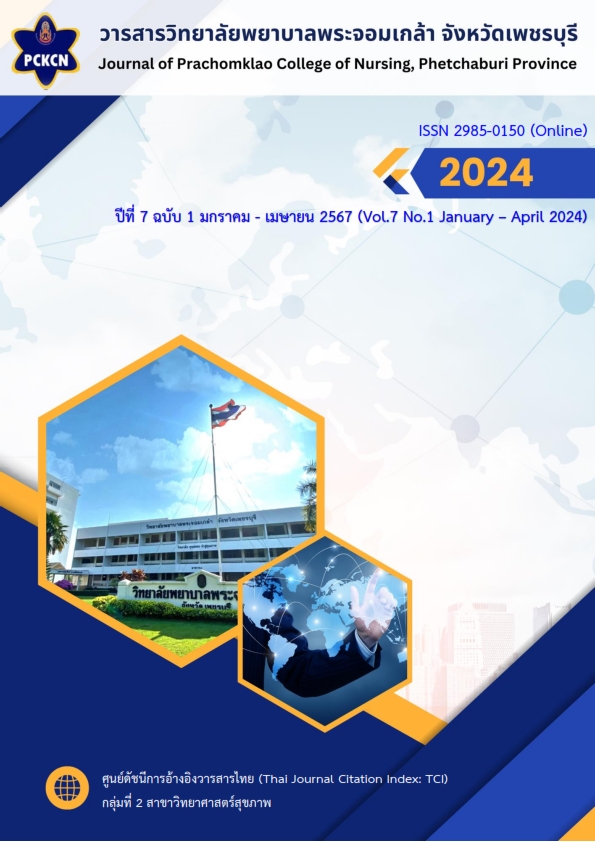การพัฒนาบริการพยาบาลผู้คลอดความดันโลหิตสูงในภาวะวิกฤต กลุ่มงานการพยาบาลผู้คลอด โรงพยาบาลพระนครศรีอยุธยา
Main Article Content
บทคัดย่อ
การวิจัยเชิงปฏิบัติการ เพื่อพัฒนาระบบบริการพยาบาลผู้คลอดความดันโลหิตสูงในภาวะวิกฤต กลุ่มงานการพยาบาลผู้คลอด โรงพยาบาลพระนครศรีอยุธยา ดำเนินการวิจัย 3 ระยะ คือ 1) ศึกษาสถานการณ์บริการพยาบาลผู้คลอดความดันโลหิตสูงในภาวะวิกฤต 2) พัฒนาแนวทางการพยาบาลผู้คลอด 3 วงล้อ ตามแนวคิดกระบวนการดูแลผู้ป่วยตามมาตรฐานเฉพาะโรค/ เฉพาะระบบของสถาบันรับรองคุณภาพสถานพยาบาล (องค์การมหาชน) และ 3) ประเมินผลลัพธ์ โดยใช้รูปแบบการวิจัยกึ่งทดลอง กลุ่มตัวอย่างเป็นพยาบาลวิชาชีพ งานห้องคลอด โรงพยาบาลพระนครศรีอยุธยาและโรงพยาบาลเครือข่าย จำนวน 30 คน และผู้คลอดที่มีภาวะความดันโลหิตสูง จำนวน 30 คน คัดเลือกกลุ่มตัวอย่างแบบเจาะจง เก็บรวบรวมข้อมูลโดยใช้แบบวัดความรู้ และแบบประเมินสมรรถนะการพยาบาลผู้คลอดความดันโลหิตสูงในภาวะวิกฤต วิเคราะห์ข้อมูลโดยใช้สถิติพรรณนา และการทดสอบที
ผลการวิจัยพบว่า ระบบบริการพยาบาลผู้คลอดความดันโลหิตสูงในภาวะวิกฤต ประกอบด้วย 1) กระบวนการดูแลผู้คลอดความดันโลหิตสูงในภาวะวิกฤต 2) แนวทางการประเมินความเสี่ยง/ ความรุนแรง 3) แนวทางบริหารยาแมกนีเซียมซัลเฟต 4) การจัดระบบการรับ-ส่งต่อแบบไร้รอยต่อ และ 5) การพัฒนาสมรรถนะพยาบาลห้องคลอดตามแนวคิดการโค้ช ผลลัพธ์การนำระบบบริการพยาบาลผู้คลอดความดันโลหิตสูงในภาวะวิกฤตไปใช้ พบว่า พยาบาลวิชาชีพมีความรู้ และสมรรถนะเพิ่มขึ้น อย่างมีนัยสำคัญทางสถิติ (p < .01) และไม่พบอุบัติการณ์หรือเหตุการณ์ที่ไม่พึงประสงค์ ได้แก่ ชักขณะนำส่ง/ ส่งต่อจากโรงพยาบาลเครือข่าย ชักขณะนำส่งมาห้องคลอด ผู้คลอดย้ายเข้าไอซียูโดยไม่ได้วางแผน และการช่วยฟื้นคืนชีพโดยไม่ได้วางแผน
การพัฒนาบริการพยาบาลผู้คลอดความดันโลหิตสูงในภาวะวิกฤต จำเป็นต้องมีการพัฒนาสมรรถนะพยาบาลตามแนวคิดการโค้ช ช่วยให้พยาบาลที่มีประสบการณ์การทำงานที่แตกต่างกัน มีความมั่นใจสามารถให้การพยาบาลได้เป็นอย่างดี ช่วยลดอุบัติการณ์ ความเสี่ยงที่ไม่พึงประสงค์ได้
Downloads
Article Details

อนุญาตภายใต้เงื่อนไข Creative Commons Attribution-NonCommercial-NoDerivatives 4.0 International License.
เนื้อหาและข้อมูลที่เผยแพร่ในวารสารวิทยาลัยพยาบาลพระจอมเกล้า จังหวัดเพชรบุรี ถือเป็นข้อคิดเห็นและความรับผิดชอบของผู้นิพนธ์บทความโดยตรง บทความ เนื้อหา ข้อมูล รูปภาพ ฯลฯ ที่ได้รับการเผยแพร่ในวารสารนี้ ถือเป็นลิขสิทธิ์ของวารสารฯ หากบุคคลหรือหน่วยงานใดต้องการนำทั้งหมดหรือส่วนหนึ่งส่วนใดไปเผยแพร่หรือเพื่อกระทำการใด ๆ จะต้องอ้างอิงวิทยาลัยพยาบาลพระจอมเกล้า จังหวัดเพชรบุรี ทุกครั้ง
เอกสารอ้างอิง
American College of Obstetricians and Gynecologists. (2015). Committee opinion No. 623: Emergency therapy for acute onset, severe hypertension during pregnancy and the postpartum period. Obstetric Gynecology, 125(2), 521-525.
Ayutthaya Hospital. (2021). Data Report 2019-2021: Service profile labor room in Ayutthaya hospital. Ayutthaya Hospital. (in Thai)
Benner, P. (2004). Using the Dreyfus model of skill acquisition to describe and interpret skill acquisition and clinical judgment in nursing practice and education. Bulletin of Science, Technology & Society, 24(3), 188-199.
Donabedian, A. (2003). An introduction to quality assurance in health care. Oxford University Press.
Health Promotion Department, Ayutthaya Provincial Health Office. (2021). Data report 2019-2021. Health Promotion Department, Ayutthaya Provincial Health Office. (in Thai)
Girvin, J. (1999). Coaching for improving job performance and satisfaction. Nursing Times, 95(50), 55-57.
Kemmis, S., McTaggart, R., & Nixon, R. (2014). The action research planner: Doing critical participatory action research. Springer.
Khamkum, I., Kasatpibal, N., & Chitreecheur, J. (2017). Effects of coaching on nurses’ knowledge and practices regarding urinary tract infection prevention in older persons in long-term care facilities. Journal of Nursing, 44(Suppl 1), 1-10. (in Thai)
Senthiri, P., Srisong, S., Prompakai, R. Sroisuwan, P, & Koponrat, K. (2017). Development of the care model for women with hypertensive disorder in pregnancy. Medical journal of Srisaket Surin Buriram Hospital, 32(2),117-129. (in Thai)
The Healthcare Accreditation Institute (Public Organization). (2020). Program and disease-specific standards. The Healthcare Accreditation Institute (Public Organization). (in Thai)
Udkhammee, K., Chuenban, P., & Chantrayotagorn, L. (2020). The effect of using professional nursing teaching techniques in compliance with patient care guidelines for surgical safety in Phrae Hospital. Journal of the Phrae Hospital, 28(2), 18-24.
World Health Organization. (2014). WHO recommendations for prevention and treatment of pre-eclampsia and eclampsia: Implications and actions. World Health Organization. https://iris.who.int/bitstream/handle/10665/119627/WHO_RHR_14.17_eng.pdf


